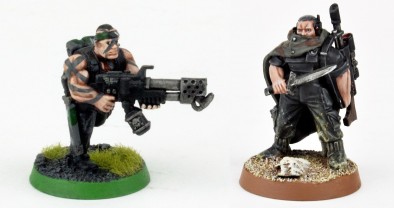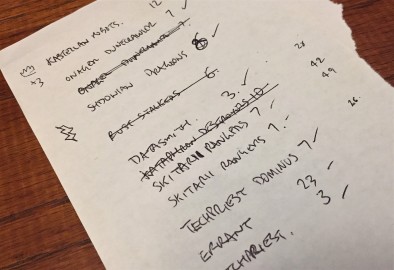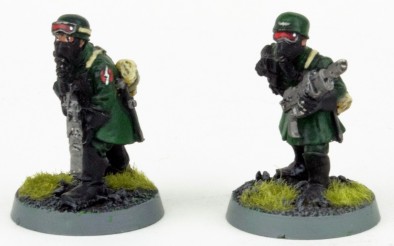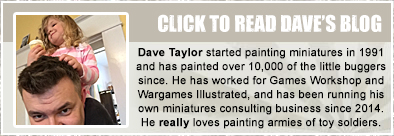Painting Wargaming Collections Part Three: Expectations
December 6, 2017 by crew
Big Projects – What are your Expectations?
Dave Taylor continues his article series on building and painting your armies, explaining his thoughts on the process from beginning to end.
Over the decades that I’ve been involved in the hobby, I’ve always derived the most joy from working on and, eventually, completing a big project. Most often that’s been an army, occasionally it has been a huge model (like my Warlord Titan) or a terrain project.
I’ve spent a lot of time talking with other hobbyists about their big projects too, and I’m always interested in hearing about the kinds of things that inspire them, help them get organized, and keep them motivated through the “dark times” that can befall any lengthy project. In this series of articles on “big projects” I hope to provide little nuggets of wisdom, gathered during my journeys.
See the Painting Wargaming Collections Article Series written by Dave
So you are now inspired to start a big project and you’ve started to map out your goals. The next step is making sure you can manage your expectations.
For much of our lives we work with the expectations of others, and their expectations of us. Our expectations – and whether or not they are met - that can affect our feelings. From “over-promising and under-delivering” leading to disappointment, to “under-promising and over-delivering” leading to excitement, when we are painting something for ourselves, we are in complete control of our expectations.
But why am I talking about “expectations” anyway? It’s all about finding a comfortable place.
In my opinion, the key to building and keeping momentum during a large project is understanding what helps you feel most comfortable? If you don’t feel comfortable working on a project, you start to think of reasons for avoiding it. Avoiding the project is only going to lead to disappointment, whereas if you feel comfortable, you’ll be happy to sit down to painting. Painting is what will get the project done.
I think there are three main categories to cover when thinking about your expectations: Quality, Quantity, and Timeline.
Quality - Are you trying to improve the quality of your painting?
It’s possible you’ve been working on some new techniques recently, or you’ve finally mastered something tricky. Practice makes perfect, right? So, it might be perfectly reasonable to expect that by the end of painting your army that your painting quality has improved. I think that is reasonable, as long as you make sure you give yourself enough time to correct mistakes and so on. If you cut back on the amount of time you spend on each model, make sure you change your expectations too.
In the photo above you can see two models that I’ve painted as troopers from the Tanith 1st (the famed Gaunt’s Ghosts). On the left was one of the first I painted in 1999, the one on the right was painted in 2015. Although the techniques I used were quite similar, more than a decade of practice meant that I could improve the quality of my painting without increasing the amount of time I spent on the model.
Quantity - Are you painting more than you really need?
Sometimes we start off by planning on painting everything we WANT to have in an army. If your timeline is altered and you don’t get to spend as much time painting as you’d like, you really should adjust your expectations.
A great way to switch it up and manage those expectations is to drop a unit or two from the painting roster (or move them to the end of the queue), leaving you with the units/models you really NEED for the army. When you reach the end of the project (or at least your important deadline) you won’t be disappointed because you’ve managed your expectations.
Timeline - Are you expecting to paint faster than you typically paint?
If you are painting a LOT of the same type of models, you can really develop some great muscle memory. By the end of the painting you are applying the paint exactly where it needs to be, no wasted brushstrokes. That might make you think that you’ll be able to paint dozens of models each week, but I would caution you to only plan to paint at the fastest you have painted before.
If you average five models per week, only plan for five models a week. If you paint more, that’s great! Also, I would suggest you expect to paint more models in the “front half” of your painting schedule. All too often I’ve seen friends say things like “I have 30 models left to paint in the next month, so I’ll paint one model per day.” This is fine as long as there is nothing that can impact the timeline.
As soon as you decide to see the latest superhero movie, or go to a parent-teacher conference (which you should totally be doing), instead of painting that one model, you start to put yourself behind the eight-ball. This can lead to feelings of not meeting your expectations, which can be quite discouraging. By front-loading your painting schedule (eg. decide to paint two models per day) you can stay quite comfortable and coast home to success in the second half of your project.
In 2000, I painted up 300 Steel Legion models to represent the Shriven (Chaos cultists from a Gaunt’s Ghosts novel) for a big display game. At the start of the project it was taking me about 45 minutes of painting time per model. Thanks to a LOT of mechanical repetition, by the time I wrapped up the final squad I was averaging 5 minutes per model (not including basing). There were no wasted brushstrokes at all. The photo above shows a model from the start of the project on the left, and from the end on the right.
As you can see by now, there is quite a bit of cross-over in these various topics – your Goals are part of Planning (the next topic we’ll cover), understanding your Expectations can help adjust your Goals and possibly dictate some of your Planning. When it comes down to it, all of this philosophizing about “the process” is leading to the Cardinal Rule:
Set yourself up for success, and not for failure.
If a project hasn’t met your expectations, is it because your expectations were unrealistic?


















































































Expectations is always something I struggle with. I’ll have a great paint job in my mind and what I end up with is never anywhere close.
Yeah, it can be tough. I often start out thinking I’m more skilled than I actually am, planning lovely blends or detailed airbrushing. Making some compromises along the way can generally get me to a happy place.
A great article so is it better to practice on the standard troops so the command unit stand out or mix it up a bit to have each unit ready together sugesions anyone everyone ?
That’s a good question, zorg. I expect the answer will be different for everyone, but for me I typically paint half the models in a unit before I tackle the command group. That way I know that I’m “over the hump” and can celebrate with a few different models.
thanks I usually do a 10 man unit at a go to keep the look even.
Definitely been struggling to find a way to enjoy painting groups of identical minis myself. What I’ve been doing so far is painting one and working on it until I’m really happy. Then I keep it on my desk and then when painting in front of me to enthuse me into painting its twins to match. One downside to newbie painter, I have definitely forgotten a few of my mixed paint ratios! Lesson learned 😛 Az
Yep, using minis you’ve just finished to keep you enthusiastic about the next ones is a great plan. I also think that if you are still struggling with the “batch painting” idea, you should just keep on painting the way you are, one at a time. For your Blood Rage set, you could paint up a few models from one clan, then switch to similar models in a different clan, depending on what you are interested in at the time. There is certainly something to be said for systems like Games Workshop uses for the Citadel paints, where there’s no… Read more »
This year I’ve find that I can get to that 1 level that I’m happy playing with in X amount of time. I can then spend that X amount of time again to get that little extra 1,05-1,5 level, and realized it’s not worth the extra X amount of time, which I could have spent on another miniature/project/squad what not. And it’s a level I’m happy with, and my expectations are there after.
Yep, knowing the level you are happy with is definitely key.